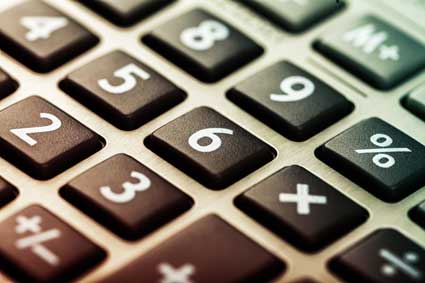In today's world, we have to remember an amazing array of numbers – phone numbers, addresses, social security numbers, account numbers, credit card numbers, and pin numbers. The list of numbers increases all the time and it quickly gets confusing. You probably also try to remember important dates (your mother-in-law's birthday) and numbers like your employee ID and your health plan number, in case you don't have your card with you!
Add in the necessity to remember other numbers temporarily, like flight numbers, locker numbers, exit numbers, street addresses when driving, and your hotel number -- and you have even more to remember.
Unfortunately, memorizing numbers is one of the most difficult things to do, because you can't "visualize" numbers the way you can visualize words, like the items on a grocery list. Fortunately, there are ways to make learning numbers easier by using some tested memory tricks.
Numbers – What You Can and Can't Remember
Most people can retain numbers between five and 10 digits long in their short-term memory for a few minutes. This is generally enough time to make a phone call, write the number down, or repeat it to another person. For instance, if someone tells you a phone number, you can probably remember it long enough to get to a phone and dial the number, because the phone number is generally seven digits long with the area code (unless you're making an international call).
If you want to transfer a number from your short-term memory to your long-term memory, however, you will need to work a bit harder. It will also take some repetition. Remember, we talked in Lesson 3 about how important repetition is to imprinting a memory on the neural pathways. Repetition works best with numbers of 10 digits or less. For longer numbers, we will talk about a more complex system later in the lesson. Along with repetition, you can use a few other techniques to break down the number into units to make the memorization easier:
Chunking
Chunking is simply breaking down a long number into smaller units, so it is easier to remember. A perfect example of this is U.S. telephone numbers, which are broken down by area code, exchange, and local number, so that instead of a string of 10 digits, you have three digits, three digits and four digits. Which of the following would be easier for you to memorize?
324-537-0961
3245370961
We thought so! So when you have a number to remember, break it into smaller units whenever possible. The government has long been aware of this, which is why your social security number is also divided up; it's easier for you to remember your number when it's broken into chunks of three digits, two digits, then four digits, instead of nine numbers all together.
Attaching Meaning
Once you've broken down a string of numbers you have to memorize into shorter chunks, try attaching some sort of meaning to each unit. This will make them easier to remember. For instance, in the numbers we looked at earlier when we discussed chunking, let's find some meaning:
324-537-0961
324….That's the same as March 24th, which is your brother's birthday -- which will be easy to remember.
537….This one is a bit harder, but in high school, your best friend's football number was 53, and your lucky number is 7.
0961…Okay -- you weren't even born yet, so you were 0, but your aunt was 9 years old in 61.
You don't have to use cues that are personally significant. If you have a number to remember like 106625, you might remember it because 1066 was when William the Conqueror invaded England and the 25th is Christmas. As long as the information helps you remember, it doesn't matter if it is personal or general – it just needs to somehow be significant.
When you have to go back and recall these numbers, it will be much easier to remember them, because each number has meaning to you. But sometimes it's hard to attach meaning to numbers, no matter how hard you try. In that case, you can attach meaning to numbers by seeing how they relate to each other within the sequence you are memorizing.
Let's stick with the same number sequence:
324-537-0961
The first three numbers are 324.
You start with 3, then subtract 1 to get the 2 (3-1=2)
Then you add 2 to get the 4. (2+2=4)
324
In the next group, the first number is two more than the first number of the first group (5 instead of 3), and you're subtracting 2 and then adding 4 -- hmm.
There's a pattern – you've doubled what was done in the first group:
(5-2=3)
(3+4=7)
537
But the next four digits are different, so we'll need to find a new pattern. You know that this set is four digits, so you know you can't use the same sequence for these numbers. Instead, you remember that it starts with 0. What comes next? Relating it to the last digit of the group before, which was a 7, you can add 2 to that number to get a new number. So now you have the 09. Now go back one more digit before the 7 and subtract that number (3), which gives you the 6. You now have 096. Any time you've subtracted or added in the past, you've increased the amount by 2 as you went, so let's try that again. Instead of subtracting 3, let's subtract 5, which leaves you with 1. It works! You now have 0961.
So all these little tricks tie together the numbers in a sort of pattern to give you:
324-537-0961
It sounds very complex, but if you read through this number a few times doing the mental arithmetic as you go, or even better, doing the math on paper, you will discover that you have this group of numbers firmly planted in your memory. In fact, next week you'll be able to clearly recall these numbers with no problem using this technique without any prompting! You won't have to write it out or consciously "do the math."You'll simply automatically be doing the figuring in your head and coming up with the sequence almost instantaneously.
There is another, more complex way to memorize numbers that's been proven to enable people to memorize impressively long numbers (like pi to the 120th decimal place). You may never need to memorize a random number that's over 100 digits long, but there are plenty of other uses for this handy little technique. For instance, if you work in Human Resources, wouldn't it be great if you could immediately recall every employee ID number without looking it up?
The Number Alphabet takes some time and effort to learn. It's probably the most time intensive method in this e-book, but if you take the time to learn it well, you will be able to use it for the rest of your life. Today every memory expert, whether he is on the lecture circuit or she uses it in her everyday life, relies on some form of the number alphabet.
The Basics of the Number Alphabet
The number alphabet relies on assigning each of the numbers from 1 to 9, plus the value 0, an alphabetical equivalent. There are reasons that specific letter values are assigned to each number, but it isn't crucial that you know these. For some people, understanding why a particular letter is matched with a particular number makes it easier to remember which ones go together, so if it helps you, we've outlined the reasons. If you don't care, just practice memorizing the ten numbers and their corresponding letters. Once you've learned this ten part memory alphabet, you will be able to memorize unlimited series of numbers easily. It may sound tedious now, but in the long run, the effort you put into learning this will give you a tremendous pay back!
1 = t or d because one stroke down makes a 1 or a t, and "d" sounds close to "t."
2 = n because two strokes down makes an "n" and an "n" on its side looks a bit like a 2.
3 = m because three strokes down makes an "m" and an "m" on its side looks like a 3.
4 = r because "4" sounds like r and "four" ends in "r."
5 = l because the Latin for 50 is L.
6 = j, ch or sh because "j" looks (sort of) like a 6, and the others sound (sort of) like "j."
7 = k or g (like in dog) because a capital "K" looks a bit like two sevens linked together, and k and hard g sound similar.
8 = f or v because a lowercase, script "f" looks a lot like an "8."
9 = b or p because "p" looks like the reflection of a "9" and a "b" is a sort of upside-down, backwards "9."
0 = z or s because zero starts with "z" and phonetically "z" and "s" sound similar.
Notice that not all of the letters of the alphabet have been used, and none of the vowels. Once you've memorized the numbers alphabet, you can use any of the letters to represent their corresponding numbers by creating words, phrases, or even sentences to stand in for long numbers. The beauty of it is that, because you haven't used all of the letters in the alphabet, you can create words around the letters by filling in with the "free" letters that are still available and don't have number equivalents.
Let's start with a few basic prices you might be checking out. You're doing some comparison shopping for a plasma television set and you find three different prices. The first one is $721.95. How will you remember this price?
Let's look at the alphabet equivalents:
7 2 1 9 5
k or g n 't or d b or p l
For the 7, let's use the word Go.
For 2, we'll use now.
For 1, you could say don't.
And the 9 could use the "b" in be.
The letter "l" can be used in late.
Now you have the sentence, "Go now, don't be late! It's an easy sentence to remember, and when you need to recall the price, you'll translate the first letter of each word back into its number:
Gndbl = 721.95
Individual Words vs. Parts of Words
You can use the letters of the numbers alphabet several ways. For shorter number sequences like this one, you can stick with using only the first letters of each word, if you like. For longer sequences of chunked sequences of numbers, you may choose to be more specific and break down words so that you are using the parts of a word to translate to numbers. For instance, if you have the number 214, it would translate to ntr. Rather than choose three separate words, each beginning with a different letter, you might want to choose one word that contains all three of the letters ntr. This might be a bit more difficult, but if 214 is part of a sequence like 214-341-32425435435354 -- well, you get the idea.
So you could turn 214 (or ntr) into nature or naughtier or neater. Remember, vowels don't count!
Individual words or parts of words? It really depends on what works best for you! But if you are going to go with individual words, keep in mind that only the letters that begin the words should be used.
Although it may seem that learning the number alphabet is more learning, rather than less learning, keep in mind that, once you learn it thoroughly the first time, you can apply it to every list you want to learn in the future. You will always be able to quickly, and nearly effortlessly, retain information using this method; so, the time you take to learn it now will yield great results in the future that will make it more than worth the effort!
































